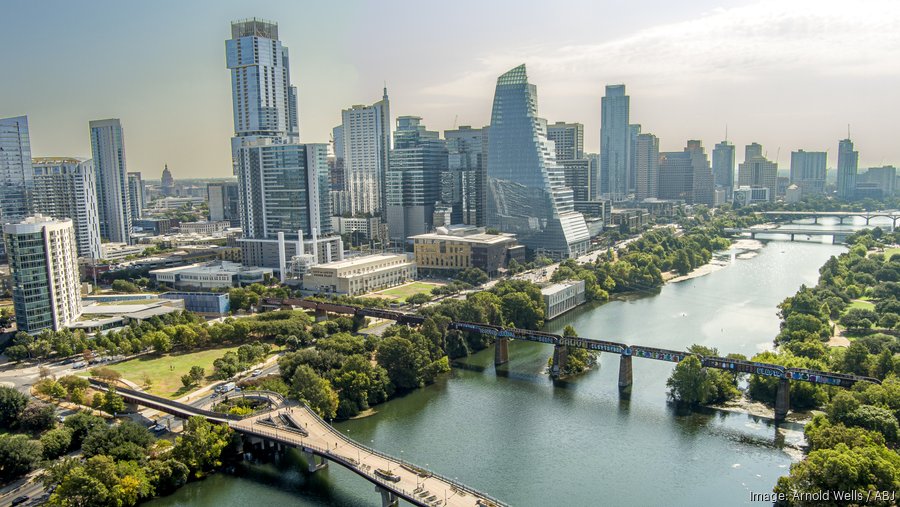Listen to this article 6 min
As downtowns continue to recover, much attention has been focused on the return to the office. But in Austin and elsewhere, new data suggests nightlife and after-hours activity is actually a bigger driver of the recovery than what's happening during the workday.
That’s according to the latest research by University of Toronto’s School of Cities, which has tracked cell-phone activity across 62 downtown metropolitan areas in the U.S. and Canada since January 2020 to gauge how recent activity compares to before the pandemic.
The data found economic diversity — including entertainment, restaurants, retail and tourism — is playing a huge role in the post-pandemic urban recovery.
In Austin, working-hour activity is still in recovery mode at 60% compared to before the pandemic, while after-hours activity during the week is up to 87%. On the weekends, downtown's recovery rate hovers at 84%.
Overall activity in Austin is at 73% recovered compared to pre-pandemic levels, higher than Dallas and Houston's recoveries but lagging San Antonio.
Relatively speaking, Austin’s downtown recovery in the years since the pandemic has been ho-hum. Office vacancy rates downtown look healthy compared to Silicon Valley, but the fact of the matter is many cities have better stats. The same goes for the percentage of people working from home and hotel occupancy.
In downtown Austin, many towers remain lifeless. There are 10 already-built towers downtown with at least 100,000 square feet of direct vacant office space — and three of the biggest and newest office blocks are completely empty despite being ready for tenants for many months, according to real estate firm Aquila Commercial LLC.
Citywide, the office vacancy rate hit 18.7% in the fourth quarter, according to Aquila. But in the CBD, that rate climbed to 22.2%, and it’s been increasing steadily since the first quarter of 2023, when the vacancy rate in the CBD was just 15.6%.
How nightlife is powering the recovery
Led by Professor Karen Chapple, School of Cities researchers found most metros are on an upward trajectory, albeit at a slower rate than before.
That's happening even though office vacancy rates are ticking up, Chapple said.
“What’s driving this slow (recovery) is not office work," she said. "Rather, we’re seeing more shopper and visitor activity that’s compensating for the loss of worker activity that we know is happening from increased office vacancy rates.”
Tucson, Arizona, may be a textbook example of this trend. Analyzing historic cell phone activity during the work week, recovery hovered around 75% of pre-pandemic rates while after-hours activity showed a recovery rate of almost 140%.
Conversely, Chapple notes Minneapolis appears to be No. 1 in upward trajectory on her team’s most recent research, but it’s at the bottom for working-hours activity. “It’s improving because it’s weeknights and weekends that are picking up.”
Charlotte, North Carolina (110%), Jacksonville, Florida (108%), and Houston, Texas (105%), all showed after-hours recovery that far superseded pre-pandemic levels while daytime figures consistently languish below 80%.
“These cities have a ton of after-hours activity, which is helping make it look like they’re recovering. But the working hours are still struggling,” Chapple said.
Flight to (suburban) quality
Fellow urbanist Richard Florida often points to Nashville as a prime example of economic diversity driving recovery.
“I think this entertainment factor, this buzz factor, has become so important,” Florida explained in an interview with The Business Journals last month. “The U.S. downtown that has recovered the best (is) Nashville, Tennessee. It’s still an affordable place to live; it’s a really nice place to work. It is a fun place for people.”
But Nashville’s suburban growth is also off the charts, part of a post-pandemic, doughnut migration trend. Not everyone is happy. Some liken the growth to “…an invisible locomotive."
Similarly, in Columbus, Ohio, suburban commercial real estate absorption is now positive, despite overall negative market absorption.
According to Collin Wheeler, a Columbus vice-president at CBRE, their market proves the theory that tenants are looking for newer, nicer buildings.
“Tenants are seeking out areas that have done a good job of ‘placemaking,’” Wheeler told Columbus Business First.
But he also cautioned that nearly two-thirds of local leases signed this past quarter in Columbus were new leases, suggesting tenants continue to downsize offices.
Chapple and her team are also closely watching commercial lease rates.
“We’ve only seen something like 40% of commercial leases come up for renewal since the beginning of the pandemic. There’s still plenty of — average 10-year leases — coming up every year,” she said. “That plays out slowly and doesn’t get resolved until 2030.”
But Chapple has never subscribed to the urban doom loop theory that has perpetuated since the pandemic.
“That doesn’t mean we’re going to have a bunch of completely empty offices," she said. “It depends on how quickly the commercial office building owners drop rents and other users come in. And that will depend on how lively downtowns are. And how much people want to be there.”
—Kathryn Hardison and Cody Baird contributed





